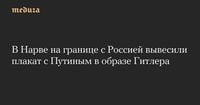In the Estonian city of Narva, a striking banner depicting Russian President Vladimir Putin in the likeness of Adolf Hitler has been prominently displayed on the wall of Hermann Castle, which sits on the border with Russia. The banner, which boldly proclaims 'Putler is a war criminal,' has garnered significant attention and sparked discussions about the ongoing conflict in Ukraine.
The Narva Museum, housed within the castle's walls, shared a photo of the banner, emphasizing its role as a reminder of the full-scale war and the war crimes committed during this conflict. Maria Smorzhevskikh-Smirnova, the museum's director, articulated the intent behind the installation, stating, "This is not a provocation, but a planned installation by the museum and the organization Propastop." Smorzhevskikh-Smirnova has been a vocal critic of the war, and this year marks the third consecutive time the museum has displayed the banner on May 9 to ensure visibility from the Russian side of the border in Ivangorod.
Every year, as part of the May 9 commemorations, the museum aims to highlight the ongoing effects of Russia's invasion of Ukraine, which has persisted for four years. Smorzhevskikh-Smirnova explained, "With the end of World War II, peace and freedom, respect for sovereignty, and the principles of solidarity became the core values of the European community. Meanwhile, the full-scale war unleashed by Putin continues right next to us." She emphasized the importance of calling a dictator a dictator and labeling war crimes as war crimes.
In early 2025, the situation took a serious turn when a court in Moscow issued an in absentia arrest warrant for Smorzhevskikh-Smirnova, accusing her of spreading 'fakes' about the Russian army for political reasons, as outlined in the Russian Criminal Code. This development underscores the risks faced by those who openly criticize the Russian government and its military actions.
On the other side of the river, which separates Narva from Russia, the city of Ivangorod prepares its own commemorations for Victory Day on May 9. Russian authorities set up a stage and screens along the embankment, ensuring that the events can be viewed from the Estonian side. In 2025, the Victory Parade was broadcast on the screen, followed by a festive concert titled 'Shores of Victory.' This juxtaposition of events highlights the contrasting narratives surrounding the historical significance of May 9 in both countries.
As tensions between Estonia and Russia remain palpable, the banner's message serves as a poignant reminder of the ongoing conflict and the differing perspectives on historical events. The actions of the Narva Museum not only reflect local sentiments but also resonate with broader European concerns regarding sovereignty, freedom, and the consequences of war.
Maria Smorzhevskikh-Smirnova's commitment to raising awareness about the war's impact is evident in her statements and actions. By displaying the banner, she aims to provoke thought and discussion about the realities of the conflict, urging people to remember the past while confronting the present challenges.
In a region where history continues to shape current events, the banner at Hermann Castle stands as a powerful statement against aggression and a call for accountability. As the world watches, the ongoing struggle for peace and justice in Ukraine remains a central issue, and the voices of those like Smorzhevskikh-Smirnova play a crucial role in keeping the conversation alive.
Ultimately, the display in Narva is more than just a piece of art; it is a bold declaration of the values that many hold dear in the face of adversity. As the conflict unfolds, the importance of dialogue, understanding, and remembrance becomes ever more critical.


